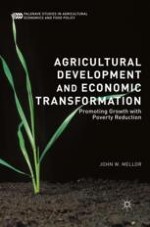This book examines the role of agriculture in the economic transformation of developing low- and middle-income countries and explores means for accelerating agricultural growth and poverty reduction. In this volume, Mellor measures by household class the employment impact of alternative agricultural growth rates and land tenure systems, and impact on cereal consumption and food security. The book provides detailed analysis of each element of agricultural modernization, emphasizing the central role of government in accelerated growth in private sector dominated agriculture. The book differs from the bulk of current conventional wisdom in its placement of the non-poor small commercial farmer at the center of growth, and explains how growth translates into poverty reduction. This new book is a follow up to Mellor’s classic, prize-winning text, The Economics of Agricultural Development.
